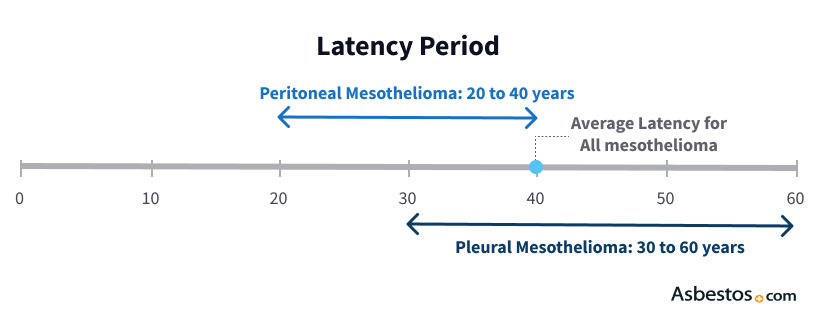Mesothelioma Latency Period
The mesothelioma latency period refers to how long it takes from when you were first exposed to asbestos to when you're diagnosed. This period typically ranges from 20 to 60 years. Your age, overall health, how much asbestos you breathed in and how long you were exposed can all affect your timeline.
How Long Does Mesothelioma Take to Develop?
Mesothelioma usually takes 20 to 60 years to develop after you first breathe in asbestos. This time gap is called the latency period. It means the cancer can grow quietly for decades before you notice any symptoms.
Key Facts About Mesothelioma Latency
- Malignant mesothelioma has a median latency period of 34 years, meaning half of people are diagnosed before then and half after.
- In rare cases, mesothelioma develops in fewer than 10 years or more than 70 years.
- Asbestos exposure at work is linked to shorter mesothelioma latency periods than environmental exposure.
- Smoking can speed up the onset of mesothelioma.
Susan Dickman tells us she was diagnosed with mesothelioma when she was 72 years old. This was nearly 60 years after her initial asbestos exposure. She says, “We were 17-years-old kicking what we thought were feathers at the time. But it was asbestos.”
External Factors That Impact Mesothelioma Latency Period
How much asbestos you were exposed to and for how long are the main factors that determine your mesothelioma latency period. The specific type of asbestos you encountered is also a factor.
For example, insulation and asbestos manufacturers had heavy exposure for a long time. They may have shorter latency periods. First responders often have high-level exposure for a brief period. Some first responders who experienced 9/11 or Hurricane Katrina developed malignant mesothelioma in a short period.
A 2025 study published in the Italian journal Epidemiology and Prevention suggests the risk of mesothelioma levels off about 40 years after asbestos exposure instead of continuing to rise. And a 2022 study found pleural mesothelioma often appears sooner than peritoneal. It also showed heavier or longer exposure can shorten the latency period.
Duration and Intensity of Asbestos Exposure
Total asbestos exposure may be the biggest factor in mesothelioma latency. Long-term asbestos exposure, or high levels for a short time, can shorten latency periods. A 2023 study of 60 years of data in the Australian Mesothelioma registry found a link between longer latency and low-level exposure.
Mesothelioma survivor Chuck Gast tells us all it took was 6 weeks of asbestos exposure for him to develop mesothelioma. Despite this very brief timeframe, both Chuck and his former wife, Melva, developed mesothelioma 40 years later. Melva’s diagnosis was the result of secondary exposure to asbestos fibers Chuck brought home on his work clothes.
Chuck shares that in 1973 while working as a teacher he took a summer job to make extra money. He tells us, “For approximately 6 weeks, I worked in an industrial furnace factory. The furnace insulation was asbestos. So, I was directly involved with it, getting it all over me.”
Occupation
Some occupations involved very heavy daily asbestos exposure. Jobs with long-term or high exposure tend to shorten the mesothelioma latency period. But there are varying latency periods among these jobs. For example, one study compared the exposure of factory workers and miners. Asbestos product workers have a shorter latency period than asbestos mine workers or those who lived near the mines.
About 1.3 million U.S. construction and general industry workers are exposed to asbestos. Renovations, maintenance and demolition can release fibers. Workers face the risk of asbestos exposure in more than 75 jobs.
Chuck shares that while working at the summer job responsible for his mesothelioma, he often handled asbestos insulation and bricks. He also hand-packed asbestos into a furnace. He tells us, “I was 27 years old and never thought something like this would come back to haunt me. That’s one job I should have never taken.”
| Occupation | Average Mesothelioma Latency Period |
|---|---|
| Mining | 35 |
| Production | 31 |
| Shipyards | 37 |
| Construction | 33 |
| Maintenance | 33 |
Secondhand Exposure
Secondhand asbestos exposure happens when asbestos fibers are transferred from one person to another. Asbestos workers may bring fibers home on their clothes and gear. This poses a threat to family members, especially if they handle contaminated items. This type of asbestos exposure can be as dangerous as direct exposure. However, it’s linked to longer latency periods.
Chuck explains that Melva’s pleural mesothelioma was a result of asbestos from his job. “I brought the [asbestos] fibers home on my clothing,” Chuck said. “She would launder my clothes.”
Melva developed symptoms a few years before Chuck noticed his own symptoms, and she was diagnosed 3 years before him. One of Chuck’s doctors in Toledo said it’s very rare for people in the same home to both have mesothelioma.
Asbestos Type
Certain types of asbestos fibers may have shorter mesothelioma latency periods. Each of the 6 types of asbestos has distinct fibers and different uses.
Crocidolite, or blue asbestos, has very thin fibers. It’s considered deadlier than other asbestos types. It also has a shorter mesothelioma latency period. A 2022 study published in Case Reports of Gastroenterology shows crocidolite is closely associated with peritoneal mesothelioma.

Access trust funds and grants to ease the cost of your treatment.
Get Help NowBiological Characteristics That Influence Mesothelioma Latency
Your overall health, gender, age, genetics and cancer type affect how long it takes for mesothelioma to develop. Peritoneal mesothelioma usually takes 20 to 40 years to develop. Pleural mesothelioma usually takes 30 to 60 years.
People who are exposed in similar ways can have different latency periods. For example, Cheryl Pilkington and Tamron Little were both exposed to asbestos when they were kids. But their latency periods were very different.
Cheryl tells us she was repeatedly exposed to asbestos at her father’s workshop. She was diagnosed with pleural mesothelioma 60 years later. Tamron was exposed to asbestos as a toddler. But she developed peritoneal mesothelioma at a young age.
Tamron shares, “I was just 21 years old when I was told I had peritoneal mesothelioma. Being diagnosed so young is a rarity. I didn’t fit the description of the typical mesothelioma patient.”

Mesothelioma Type
The site of your tumors can affect your mesothelioma latency period. When looking at all mesothelioma types together, the latency period is 20 to 60 years. But some of the rarer forms of the disease develop even more quickly.
Latency Periods of Mesothelioma
- Pericardial and testicular mesothelioma: These rare types of mesothelioma have shorter latency of 20 to 30 years. The testicular type can develop in fewer than 20 years in some cases.
- Peritoneal mesothelioma: Peritoneal mesothelioma has a latency period of 20 to 40 years.
- Pleural mesothelioma: This is the most common type and tends to develop over the course of 30 to 60 years.
One study found a much shorter latency for peritoneal mesothelioma than for pleural. This study found the average latency for pleural mesothelioma was 44 years. For peritoneal mesothelioma, it was under 30 years for women and 39 years for men.
Gender
Some studies suggest women tend to have a longer mesothelioma latency than men. This may be attributable to higher rates of environmental exposure among women. The mean mesothelioma latency period for men is 48 years. The mean mesothelioma latency period for women is 53 years.
Recent data shows mesothelioma rates have risen among women. This is despite traditionally lower exposure to asbestos at work. Asbestos-contaminated talc in some cosmetics may play a role. Women may have used these products more often than men.
Age
Some research suggests that your age at the time of your asbestos exposure may affect mesothelioma latency. Being younger when you’re first exposed is associated with longer latency periods. But very young children and older adults may be at higher risk of getting sick from asbestos exposure.
Children’s immune systems are still developing. And immune systems can decline with age. This may mean very young children and older adults’ bodies are less able to clear asbestos. However, children have a longer average mesothelioma life expectancy than adults.
Alyssa Hankus was diagnosed with peritoneal mesothelioma when she was only 15. Alyssa has been in remission for more than 15 years after aggressive treatment. She tells us she doesn’t take life for granted.
“It’s all a part of that continued fight of making it and achieving all of the things that at 15 I was told I never would. Those little day-to-day simple joys are what mean so much, because those were never promised to me. My doctors told me it takes at least 15 years to present symptoms, but I actually started showing symptoms around age 12.”
Genetics and Gene Mutations
Some people are genetically more likely to develop cancer. Genetic predisposition may also affect asbestos latency. Certain gene mutations may lead to shorter latency periods.
A 2022 case report in Frontiers in Oncology shows 12 genes are linked to mesothelioma. Mutations to the BRCA-1 gene, which suppresses tumor development, may raise the risk of mesothelioma. A mutation in the related BAP1 gene may shorten the latency period for mesothelioma.
The BAP1 mutation is linked to a shorter latency period. It can contribute to cases of mesothelioma among young people exposed to asbestos. More research is necessary to confirm if genes influence mesothelioma latency.
How Latency Period Affects Mesothelioma Diagnosis
Because mesothelioma’s latency period means symptoms take so long to appear, many people don’t get diagnosed with mesothelioma until the disease is advanced. By the time some people feel symptoms, they may not connect their past asbestos exposure to what they’re experiencing now.
Symptoms of mesothelioma also mimic common illnesses, which can lead to an initial misdiagnosis. For example, pleural effusion can be mistaken for pneumonia or heart failure. Common symptoms of pleural mesothelioma include a cough that won’t go away and trouble breathing.
Because mesothelioma is very rare, doctors don’t typically suspect mesothelioma unless they’re aware of asbestos exposure. If you served in the military, worked in construction, or had a job in other higher-risk jobs, you may have experienced primary asbestos exposure. If you lived with someone with primary exposure, you may have been at risk for secondary exposure. It’s important to share that information with your doctor.
Common Questions About Mesothelioma Latency Period
- Does smoking affect mesothelioma latency?
-
Smoking, in any amount, seems to shorten the latency period for mesothelioma.
- How does asbestosis affect the latency period for mesothelioma?
-
People with asbestosis can experience a shorter latency period with mesothelioma. The presence of asbestosis is a sign that a person had heavy exposure to asbestos. Shorter latency periods for mesothelioma are associated with heavy asbestos exposure.
- What symptoms might indicate mesothelioma?
-
The most common symptoms of mesothelioma are a lingering dry cough and trouble breathing.
- What should I do if I have a known history of asbestos exposure?
-
If you have a known history of asbestos exposure, talk to your doctor. Ask about screenings for asbestos-related diseases.






